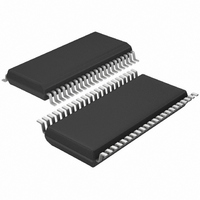LTC2704IGW-14#PBF Linear Technology, LTC2704IGW-14#PBF Datasheet - Page 11

LTC2704IGW-14#PBF
Manufacturer Part Number
LTC2704IGW-14#PBF
Description
IC DAC 14BIT QUAD VOUT 44-SSOP
Manufacturer
Linear Technology
Datasheet
1.LTC2704IGW-12PBF.pdf
(22 pages)
Specifications of LTC2704IGW-14#PBF
Settling Time
9µs
Number Of Bits
14
Data Interface
Serial, SPI™
Number Of Converters
4
Voltage Supply Source
Analog and Digital, Dual ±
Operating Temperature
-40°C ~ 85°C
Mounting Type
Surface Mount
Package / Case
44-SSOP
Lead Free Status / RoHS Status
Lead free / RoHS Compliant
Power Dissipation (max)
-
Available stocks
Company
Part Number
Manufacturer
Quantity
Price
OPERATION
SERIAL INTERFACE
When the CS/LD pin is taken low, the data on the SDI pin
is loaded into the shift register on the rising edge of the
clock signal (SCK pin). The minimum (24-bit wide) loading
sequence required for the LTC2704 is a 4-bit command
word (C3 C2 C1 C0), followed by a 4-bit address word
(A3 A2 A1 A0) and 16 data (span or code) bits, MSB
fi rst. Figure 1 shows the SDI input word syntax to use
when writing a code or span. If a 32-bit input sequence is
needed, the fi rst eight bits must be zeros, followed by the
same sequence as for a 24-bit wide input. Figure 2 shows
the input and readback sequences for both 24-bit and
32-bit operations.
When CS/LD is low, the Serial Readback Output (SRO)
pin is an active output. The readback data begins after
the command (C3-C0) and address (A3-A0) words have
been shifted into SDI. For a 24-bit load sequence, the 16
readback bits are shifted out on the falling edges of clocks
8-23, suitable for shifting into a microprocessor on the
rising edges of clocks 9-24. For a 32-bit load sequence,
add 8 to these clock cycle counts; see Figure 2b.
When CS/LD is high, the SRO pin presents a high impedance
(three-state) output. At the beginning of a load sequence,
when CS/LD is taken low, SRO outputs a logic low until
the readback data begins.
When the asynchronous load pin, LDAC, is taken low, all
DACs are updated with code and span data (data in B1
buffers is copied into B2 buffers). CS/LD must be high
during this operation. The use of LDAC is functionally
identical to the “Update B1→B2” commands.
The codes for the command word (C3-C0) are defi ned in
Table 1; Table 2 defi nes the codes for the address word
(A3-A0).
READBACK
Each DAC has two pairs of double-buffered digital regis-
ters, one pair for DAC code and the other for the output
span (four buffers per DAC). Each double-buffered pair
comprises two registers called buffer 1 (B1) and buffer
2 (B2).
B1 is the holding buffer. When data is shifted into B1 via
a write operation, DAC outputs are not affected. The con-
tents of B2 can only be changed by copying the contents
of B1 into B2 via an update operation (B1 and B2 can be
changed together, see commands 0110-1001 in Table 1).
The contents of B2 (DAC code or DAC span) directly control
the DAC output voltage or the DAC output range.
Additionally each DAC has one readback register associated
with it. When a readback command is issued to a DAC, the
contents of one of its four buffers is copied into its readback
register and serially shifted out onto the SRO pin. Figure 2
shows the loading and readback sequences. In the 16-bit
data fi eld (D15-D0 for the LTC2704-16, see Figure 2a) of
any write or update command, the readback pin (SRO)
shifts out the contents of the buffer which was specifi ed in
the preceding command. This “rolling readback” mode of
operation can be used to reduce the number of operations,
since any command can be verifi ed during succeeding
commands with no additional overhead. Table 1 shows
the location (readback pointer) of the data which will be
output from SRO during the next instruction.
For readback commands, the data is shifted out during the
readback instruction itself (on the 16 falling SCK edges im-
mediately after the last address bit is shifted in on SDI).
When programming the span of a DAC, the span bits are
the last four bits shifted in; and when checking the span of
a DAC using SRO, the span bits are likewise the last four
bits shifted out. Table 3 shows the span codes.
When span information is read back on SRO, the sleep
status of the addressed DAC is also output. The sleep status
bit, SLP , occurs sequentially just before the four span bits.
The sequence is shown in Figures 2a and 2b. See Table 4
for SLP codes. Note that SLP is an output bit only; sleep
is programmed by using command code 1110 along with
the desired address. Any update command, including the
use of LDAC, wakes the addressed DAC(s).
LTC2704
11
2704fc

















